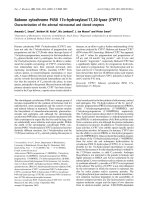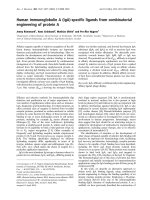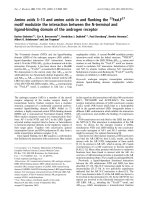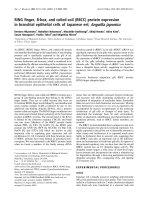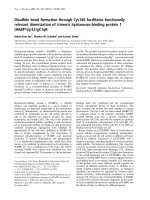Báo cáo y học: "Newly discovered KI, WU, and Merkel cell polyomaviruses: No evidence of mother-to-fetus transmission" doc
Bạn đang xem bản rút gọn của tài liệu. Xem và tải ngay bản đầy đủ của tài liệu tại đây (230.74 KB, 5 trang )
RESEARC H Open Access
Newly discovered KI, WU, and Merkel cell
polyomaviruses: No evidence of mother-to-fetus
transmission
Mohammadreza Sadeghi
1
, Anita Riipinen
2
, Elina Väisänen
1
, Tingting Chen
1
, Kalle Kantola
1
, Heljä-Marja Surcel
3
,
Riitta Karikoski
4
, Helena Taskinen
2,5
, Maria Söderlund-Venermo
1
, Klaus Hedman
1,6*
Abstract
Background: Three* human polyomaviruses have been discovered recently, KIPyV, WUPyV and MCPyV. These
viruses appear to circulate ubiquitously; however, their clinical sig nificance beyond Merkel cell carcinoma is almost
completely unknown. In particular, nothing is known about their preponderance in vertical transmission. The aim
of this study was to investigate the frequency of fetal infections by these viruses. We sought the three by PCR, and
MCPyV also by real-time quantitative PCR (qPCR), from 535 fetal autopsy samples (heart, liver, placenta) from
intrauterine fetal deaths (IUFDs) (N = 169), miscarriages (120) or induced abortions (246). We also measured the
MCPyV IgG antibodies in the corresponding maternal sera (N = 462) mostly from the first trimester.
Results: No sample showed KIPyV or WUPyV DNA. Interestingly, one placenta was reproducibly PCR positive for
MCPyV. Among the 462 corresponding pregna nt women, 212 (45.9%) were MCPyV IgG seropositive.
Conclusions: Our data suggest that none of the three emerging polyomaviruses often cause miscarriages or
IUFDs, nor are they transmitted to fetuses. Yet, more than half the expectant mothers were susceptible to infection
by the MCPyV.
Background
Among the five* human polymaviruses known, aside
from the BK virus (BKV) and JC virus (JCV) [1,2],
three* new ones, KI polyomavirus (KIPyV), WU polyo-
mavirus (WUPyV), and Merkel cell polyomavir us
(MCPyV) have been discovered during the past few
years by use of advanced molecular techniques [3-5]. In
their DNA sequences, KIPyV and WUPyV are interre-
lated more than MCPyV, which differs from all the
human polyomaviruses known [6]. The KIPyV and
WUPyV were discovered in nasopharyngeal aspirates
(NPA) from children with respiratory tract infections
[3,4]. Although many reports have confirmed their pre-
sence in the upper airways of patients with respiratory
illness, evidence is la cking of their pathogenicity in this
context [7-10,12]. For these viruses, their tropism and
clinical significance are unknown. Likewise, for the
tumorigenic MCPyV [5], also found in the nasopharynx
[13-15], the mode of transmission and, host cells, as
well as latency characteristics are yet to be established.
MCPyV DNA has been detected in a variety of speci-
men types including skin, saliva, gut, and respiratory
secretion samples [5,16,17]. Recovery of complete
MCPyV genomes from the skin of 40% of healthy adults
and PCR detection of MCPyV in the s kin of almost all
adults by cutaneous swabbing suggests that most adult s
are persistently infected with this polyomavirus [18].
Another recent study revealed the viral DNA in environ-
mental samples (sewage and rive r water) [19], confirm-
ing that MCPyV indeed is a ubiquitous virus.
Serological studies have sho wn that initial exposure
to KIPyV and WUPyV, as well as MCPyV occurs often
in childhood, similar to that for BKV and JCV, and
that MCPyV circulates widely in t he human population
[20-24]. Although most adults have been exposed to
MCPyV, the exact site(s) of MCPyV infection remain
unclear. Vertical transmission of many human DNA
and RNA viruses is well established. However, for
* Correspondence:
1
Department of Virology, Haartman Institute, University of Helsinki, BOX 21,
FIN-00014, Helsinki, Finland
Full list of author information is available at the end of the article
Sadeghi et al. Virology Journal 2010, 7:251
/>© 2010 Sadeghi et al; licensee BioMed Central Ltd. This is an Open Access article distributed under the terms of the Creative Commons
Attribution License ( ), which permits unrestrict ed use, distribution, and reproduction in
any medium, provided the original work is properly cited.
Polyomaviridae this mode of transmission is far from
clear. Transplacental transmission of BKV was first
suggested by detection of the virus DNA in fetal tis-
sues [25], while others obtained no evide nce of vertical
transmission [26]. IgM studies of BKV and JCV in
cord blood samples showed no apparent association
with congenital infection [27,28].
These findings prompted us to investigate a sizeable
material of fetal autopsy samples (placenta, heart, liver)
for the presence of the three polyomaviruses in order
to determine whether these viruses give rise to fetal
infections. We also studied the corresponding maternal
sera for MCPyV IgG antibodies, by a newly established
virus like particle (VLP) - based IgG assay (Chen et al,
in revision).
Materials and methods
Clinical samples
The DNA studies were carri ed out using formalin-fixed,
paraffin-embedded (FFPE) tissues - placenta, heart, and
liver - after intrauterine fetal deaths (IUFDs, N = 169),
miscarriages (N = 120), or using as controls, specimens
from induced abortions (N = 246) performed exclusively
due to medical indications. From each fetus, 3 organs
(when available; placenta, heart, and liver) were initially
studied in poo ls, by P CR for the three polyomaviruses
(KI, WU, and MC). In the positive pool its constituent
tissues (placenta and heart) were then re-examined
separately. Thus, a t otal of 535 fetuses were included in
the overall cohort. The sampling in the Helsinki region
occurred from July 1992 to December 1995 and January
2003 to December 2005 [29]. The gestational weeks of
the fetal deaths ranged from 11 to 42. In this study,
IUFD corresponds to fetal loss having occurred during
or after the 22nd gestational week, and miscarriage to
fetal loss having occurred earlier. Our number of IUFDs
represents 58% of all occurring in Helsinki during the
study period.
Wefurthermoreexaminedforthepresenceof
MCPyV IgG antibodies all serum samples available
from the corresponding mothers (n = 462). T hese sam-
ples had been collected at the municipal maternity
centers during antenatal screening around the 9th
gestational week (mean 9; median 9; range 2 to 36)
and were stored frozen at the Finnish Maternity
Cohort, National Institute for Health and Welfare,
Oulu, Finland. The mothers’ ages ranged between 18
and 45 years (mean 31, median 31).
The study was approved by the Coordinating Ethics
Committee of the Hospital District of Helsinki and
Uusimaa. Permission for use of fetal tissues was
obtained from the National Supervisory Authority for
Welfare and Health (Valvira).
DNA preparation and PCRs
The paraffin blocks were punch-biopsied, proteinase
K-digested, and the DNA was prepared by salting out,
as described [29]. Briefly, tissue lysates were heated at
95°C for 10 min. The paraffin then appeared floating on
the surface, after centrifugation at 13,200 rpm for 5 min-
utes (Eppendorf; 4°C). Sodium chloride was added to
achieve a final concentration of 1.2 mol/L, and the sam-
ple was mixed for 20 s and recentrifuged. The superna-
tant was transferred to a new tube, carefully avoiding
particles. The DNA in the supernatant was precipitated
with absolute ethanol and was redissolved in 60 mL of
water. The DNA solution diluted 1 to 10 was stored at -
20°C until use. W ater, as a negative co ntrol, was
inserted between every 20 samples and was prepared
along with the tissue pools.
All these DNA preparations were b -glo bin-PCR-posi-
tive, pointing to DNA stability and lack of appreciable
PCR inhibition. The WUPyV and KIPyV nested PCRs
employed primer set A (table 1) [12]. For MCPyV DNA
detection by qualitative PCRs, two primer sets were
used (table 1); all samples were first studied by the LT3
nested PCR [15], and were reanalyzed by the LT1/M1
nested PCR [30], and samples with positive results by
agarose gel electrophoresis were DNA sequenced. As
short PCR products ought to be used when working
with FFPE tissues [31,32] we reanalyzed all pools with a
real-time quantitative PCR with an amplicon length of
59 bp, as described [13].
PCR sensitivity
For detection of KIPyV/WUPyV and MCPyV we per-
formedahighlysensitivePCRassay[15].Aspositive
controls and to determine assay sensitivities by limiting
dilution analysis, plasmids containing the VP2 gene of
WUPyV (EU693907) and KIPyV (EU358767) and th e
LT3 amplification product of MCPyV (EU375803) were
constructed; the amplificatio n products of the VP2
genes were cloned into pCR8/GW/TOPO (Invitrogen;
Carlsbad, CA, USA) whereas the MCPyV LT3 region
was synthesized and cloned into p GOv4 by Gene Ora-
cle, Inc. (San Leandro, USA). In the MCPyV and
KIPyV/WUPyV assays, plasmid controls with 30 and 5
copies/reaction were reproducibly positive, respectively.
Of note, the sensitivities wereunaffectedbytheinclu-
sion of genomic human DNA from c ultured 293T cells
at 100 ng per reaction (4 ng/μl). In non-nested format
with 40 PCR cycles the LT3 primers had a sensitivity 1
log lower than that of the nested assay both in the pre-
sence and absence of human genomic DNA. In addition,
we also used a previously established real time quantita-
tive PCR for MCPyV, where a plasmid control with 2
copies/reaction was reproducibly positive [13].
Sadeghi et al. Virology Journal 2010, 7:251
/>Page 2 of 5
Sequence analyses
The MCPyV PCR products were purified for automated
sequencing using the High Pure PCR p roduct purifica-
tion kit (Roche). The resulting DNA sequences using
BLAST were aligned against the reference sequences in
GenBank including accession numbers of [gb|
EU375803.1]; [gb|EU375804.1]; [gb|FJ173815.1]; [gb|
FJ464337.1]; [gb|HM011538] and [gb|HM011557].
MCPyV antibody EIA
MCPyV IgG antibodies were measured by EIA based on
virus protein 1 (VP1) VLPs (Chen et al, in revision).
Briefly, the VP1-VLPs expressed in insect cells and
purified by CsCl density gradient centrifugation were
biotinylated and attached (at 60 ng/well) to streptavidin-
coated microtiter plates (Thermo Scientific) and
saturated with a sample diluent (Ani Labsystems). The
sera (1:200) were applied in duplicate, the bound IgG
were quantified with peroxidase-conjugated anti-human
IgG (1:2000; DakoCytomation) using H
2
O
2
and OPD
substrates, and the absorbances at 492 nm were read
after blank subtraction. The EIA cut-off for IgG positiv-
ity is 0.120 OD units.
Results and Discussion
Among the 535 fetal autopsy samples studied in pools,
none was PCR positive for KIPyV or WUPyV DNA. On
the other hand, one pool was positive for MCPyV by
the LT3 PCR. Tissue samples from 2 sites were available
for further study of this fetus. On retesting of the pla-
centa and fetal heart separately, the heart was PCR
negative and the placenta was positive for MCPyV.
However, it was negative by the LT1/M1 PCR for
MCPyV. DNA preparations re-extracted from the other
half of the same punch biopsy, as well as those obtained
via another punch from the same paraffin block, showed
exactly the same MCPyV DNA results. Furthermore, we
studied all samp les with a real-time qPCR for MCPyV
of a different genomic region, with an identical result;
the placenta was positive with a Ct value of 38.4, while
the biopsy from the fetal heart was negative. To verify
the specificity of the amplified products and to detect
possible genomic variants, the MCPyV LT3 PCR pro-
ducts were sequenced. They showed 100% homology
with all the existing database sequences. N.B., the mis-
carried fetus, with gastroschisis and umbilical cord com-
plications, was deceased in 1994, in gestational week 17.
In addition, we examined for circulating MCPyV IgG
antibodies the corresponding pregnant women. Of the
462 maternal sera, 45.9% (212) showed positive results.
We searched formalin-fixed, paraffin-embedded tissues
- placenta, heart, and liver - of 535 fetal autopsy samples
fortheKI,WU,andMCpolyomaviruses.Wefoundno
genomic DNAs of KIPyV or WUPyV in any of the s till-
born or deceased fetuses. This suggests that during the
study period neither of these two newly found viruses (i)
often caused miscarriages or IUFDs, (ii) nor were inci-
dentally (as bystanders) transmitted to remain in the
fetuses succumbing for other reasons. Whether the
exclusive mechanism in our mid-size series was the ser-
endipitous absence of maternal infe ctions (primary; sec-
ondary) caused by these viruses, or pathogenetic
resistance by other mechanisms, remains to be shown.
On the other hand, it was interesting to observe LT3
PCR and VP1 qPCR positivity for MCPyV (reproducibly,
and of correct DNA sequence) in the placenta of o ne
mis carriage in the 17th gestational week. The negat ivity
of this placenta with the other MCPyV PCR (LT1/M1)
maybeduetotheknownsensitivitydifferenceofthe
PCR assays [15,30].
As for the previously known human polyomaviruses
BKV and JCV, no fetal autopsy materials have been
found positive for JCV DNA, whereas one study [25]
reported a high genoprevalence of BKV DNA; BKV ver-
tical transmission has been denied by others [11,33,34],
however.
Ours is to our knowledge the first study in which fetal
tissues have been searched for the newly discovered
Table 1 Primers and probe used to detect KIPyV, WUPy and MCPyV
PCR and Virus Primer Sequence 5 ® 3 Region Amplicon size
Forward Reverse
Nested PCR outer primers
KIPyV, WUPyV ATCTRTAGCTGGAGGAGCAGAG CCYTGGGGATTGTATCCTGMGG VP2 336 bp
MCPyV (LT3) TTGTCTCGCCAGCATTGTAG ATATAGGGGCCTCGTCAACC LT 309 bp
MCPyV (LT1) TACAAGCACTCCACCAAAGC TCCAATTACAGCTGGCCTCT LT 440 bp
Nested PCR inner primers
KIPyV, WUPyV RTCAATTGCTGGWTCTGGAGCTGC TCCACTTGSACTTCCTGTTGGG VP2 277 bp
MCPyV (LT3) TGACGTGGGGAGAGTGTTTTTG GAGGAAGGAAGTAGGAGTCTAGAAAAG LT 155 bp
MCPyV (M1) GGCATGCCTGTGAATTAGGA TTGCAGTAATTTGTAAGGGGACT LT 179 bp
MCPyV qPCR primers TGCCTCCCACATCTGCAAT GTGTCTCTGCCAATGCTAAATGA VP1 59 bp
MCPyV probe FAM-TGTCACAGGTAATATC-MGBNFQ
Sadeghi et al. Virology Journal 2010, 7:251
/>Page 3 of 5
human polyomaviruses. Serology has shown that a high
proportion of adul ts have been exposed to MCPyV, and
that the infection can be acquired early in life [20-24].
We detected an IgG seroprevalence for MCPyV of
45.9% among the pregnant women. This value is in line
with previous reports and shows that more than half
our women were susceptible to MCPyV infection. Tol-
stov et al. studying serologically 6 children 1 year or
younger found no evidence of MCPyV vertical transmis-
sion [24].
Conclusions
While the three* emerging polyomaviruses occur fre-
quently in tissues of many different types, and MCPyV
also in environmental samples [3,4,13,15,18,35], our
PCR data from 535 pregnancies suggest that none of
these viruses are frequently transmitted vertically.
Further studies with larger populations may, however,
be warranted to determine which role, if any, MCPyV
plays in pregnant women and their offspring.
Acknowledgements
This study was supported by the Helsinki University Central Hospital
Research & Education and Research & Development funds, the Sigrid
Jusèlius Foundation, the Medical Society of Finland (FLS), and the Academy
of Finland (project code 1122539). M.S. expresses his gratitude to the
Ministry of Science, Research and Technology of Iran for a research
scholarship as well as to Bu-Ali Sina University, Hamedan for the opportunity
to advanced studies. For friendly help with language revision we are much
indebted to Carolyn Brimley Norris from language services of Helsinki
University.
*Note added in proof: Since the work described in this paper was
completed and submitted for publication, another previously unknown
human polyomavirus, TSPyV, was identified by Van der Meijden et al, (PLoS
Pathog 2010;6, e1001024), bringing to six the number human
polyomaviruses known.
Author details
1
Department of Virology, Haartman Institute, University of Helsinki, BOX 21,
FIN-00014, Helsinki, Finland.
2
Centre for Expertise for Health and Work Ability,
Finnish Institute of Occupational Health, Topeliuksenkatu 41 a A, FIN-00250,
Helsinki, Finland.
3
National Institute for Health and Welfare, P.O. Box 301, FIN-
90101, Oulu, Finland.
4
Department of Pathology, Helsinki University Central
Hospital Laboratory Division, Haartmaninkatu 3, FIN 00290, Helsinki, Finland.
5
Department of Public Health, University of Helsinki, BOX 21, FIN-00014,
Helsinki, Finland.
6
Department of Virology, Helsinki University Central
Hospital Laboratory Division, Haartmaninkatu 3, FIN 00290, Helsinki, Finland.
Authors’ contributions
MS carried out the PCR and serological assays, analyzed the data, and
participated in writing. AR and EV organized the clinical materials and
carried out the DNA extractions. TC accounted for the serology part. KK
participated in the methods design and setup. HMS, RK, and HT collected
the specimens and contributed to the data analysis. MSV and KH conceived
the study, participated in its design and coordination and accounted for the
manuscript writing. All authors read and approved the final manuscript.
Competing interests
The authors declare that they have no competing interests.
Received: 17 August 2010 Accepted: 22 September 2010
Published: 22 September 2010
References
1. Gardner SD, Field AM, Coleman DV, Hulme B: New human papovavirus (B.
K.) isolated from urine after renal transplantation. Lancet 1971,
1(7712):1253-1257.
2. Padgett BL, Walker DL, ZuRhein GM, Eckroade RJ, Dessel BH: Cultivation of
papova-like virus from human brain with progressive multifocal
leucoencephalopathy. Lancet 1971, 1(7712):1257-1260.
3. Allander T, Andreasson K, Gupta S, Bjerkner A, Bogdanovic G, Persson MA,
Dalianis T, Ramqvist T, Andersson B: Identification of a third human
polyomavirus. J Virol 2007, 81(8):4130-4136.
4. Gaynor AM, Nissen MD, Whiley DM, Mackay IM, Lambert SB, Wu G,
Brennan DC, Storch GA, Sloots TP, Wang D: Identification of a novel
polyomavirus from patients with acute respiratory tract infections. PLoS
Pathog 2007, 3(5):e64.
5. Feng H, Shuda M, Chang Y, Moore PS: Clonal integration of a
polyomavirus in human Merkel cell carcinoma. Science 2008,
319(5866):1096-1100.
6. Dalianis T, Ramqvist T, Andreasson K, Kean JM, Garcea RL: KI, WU and
Merkel cell polyomaviruses: a new era for human polyomavirus
research. Semin Cancer Biol 2009, 19(4):270-275.
7. Le BM, Demertzis LM, Wu G, Tibbets RJ, Buller R, Arens MQ, Gaynor AM,
Storch GA, Wang D: Clinical and epidemiologic characterization of WU
polyomavirus infection, St. Louis, Missouri. Emerg Infect Dis 2007,
13(12):1936-1938.
8. Abedi Kiasari B, Vallely PJ, Corless CE, Al-Hammadi M, Klapper PE: Age-
related pattern of KI and WU polyomavirus infection. J Clin Virol 2008,
43(1):123-125.
9. Ren L, Gonzalez R, Xie Z, Zhang J, Liu C, Li J, Li Y, Wang Z, Kong X, Yao Y,
Hu Y, Qian S, Geng R, Yang Y, Vernet G, Paranhos-Baccala G, Jin Q, Shen K,
Wang J: WU and KI polyomavirus present in the respiratory tract of
children, but not in immunocompetent adults. J Clin Virol 2008,
43(3):330-333.
10. Wattier RL, Vazquez M, Weibel C, Shapiro ED, Ferguson D, Landry ML,
Kahn JS: Role of human polyomaviruses in respiratory tract disease in
young children. Emerg Infect Dis 2008, 14(11):1766-1768.
11. Coleman DV, Wolfendale MR, Daniel RA, Dhanjal NK, Gardner SD, Gibson PE,
Field AM: A prospective study of human polyomavirus infection in
pregnancy. J Infect Dis 1980, 142(1):1-8.
12. Norja P, Ubillos I, Templeton K, Simmonds P: No evidence for an
association between infections with WU and KI polyomaviruses and
respiratory disease. J Clin Virol 2007, 40(4):307-311.
13. Goh S, Lindau C, Tiveljung-Lindell A, Allander T: Merkel cell polyomavirus
in respiratory tract secretions. Emerg Infect Dis 2009, 15(3):489-491.
14. Bialasiewicz S, Lambert SB, Whiley DM, Nissen MD, Sloots TP: Merkel cell
polyomavirus DNA in respiratory specimens from children and adults.
Emerg Infect Dis 2009, 15(3):492-494.
15. Kantola K, Sadeghi M, Lahtinen A, Koskenvuo M, Aaltonen LM, Mottonen M,
Rahiala J, Saarinen-Pihkala U, Riikonen P, Jartti T, Ruuskanen O, Soderlund-
Venermo M, Hedman K: Merkel cell polyomavirus DNA in tumor-free
tonsillar tissues and upper respiratory tract samples: implications for
respiratory transmission and latency. J Clin Virol 2009, 45(4):292-295.
16. Loyo M, Guerrero-Preston R, Brait M, Hoque M, Chuang A, Kim M,
Sharma R, Liegeois N, Koch W, Califano J, Westra W, Sidransky D:
Quantitative detection of merkel cell virus in human tissues and
possible mode of transmission. Int J Cancer 2009.
17. Wieland U, Mauch C, Kreuter A, Krieg T, Pfister H: Merkel cell polyomavirus
DNA in persons without merkel cell carcinoma. Emerg Infect Dis 2009,
15(9):1496-1498.
18. Schowalter RM, Pastrana DV, Pumphrey KA, Moyer AL, Buck CB: Merkel cell
polyomavirus and two previously unknown polyomaviruses are
chronically shed from human skin. Cell Host Microbe 2010, 7(6):509-515.
19. Bofill-Mas S, Rodriguez-Manzano J, Calgua B, Carratala A, Girones R: Newly
described human polyomaviruses Merkel cell, KI and WU are present in
urban sewage and may represent potential environmental
contaminants. Virol J 2010, 7(1):141.
20. Kean JM, Rao S, Wang M, Garcea RL: Seroepidemiology of human
polyomaviruses. PLoS Pathog 2009, 5(3):e1000363.
21. Nguyen NL, Le BM, Wang D: Serologic evidence of frequent human
infection with WU and KI polyomaviruses. Emerg Infect Dis 2009,
15(8):1199-1205.
Sadeghi et al. Virology Journal 2010, 7:251
/>Page 4 of 5
22. Carter JJ, Paulson KG, Wipf GC, Miranda D, Madeleine MM, Johnson LG,
Lemos BD, Lee S, Warcola AH, Iyer JG, Nghiem P, Galloway DA: Association
of Merkel cell polyomavirus-specific antibodies with Merkel cell
carcinoma. J Natl Cancer Inst 2009, 101(21):1510-1522.
23. Pastrana DV, Tolstov YL, Becker JC, Moore PS, Chang Y, Buck CB:
Quantitation of human seroresponsiveness to Merkel cell polyomavirus.
PLoS Pathog 2009, 5(9):e1000578.
24. Tolstov YL, Pastrana DV, Feng H, Becker JC, Jenkins FJ, Moschos S, Chang Y,
Buck CB, Moore PS: Human Merkel cell polyomavirus infection II. MCV is
a common human infection that can be detected by conformational
capsid epitope immunoassays. Int J Cancer 2009, 125(6):1250-1256.
25. Pietropaolo V, Di Taranto C, Degener AM, Jin L, Sinibaldi L, Baiocchini A,
Melis M, Orsi N: Transplacental transmission of human polyomavirus BK.
J Med Virol 1998, 56(4):372-376.
26. Boldorini R, Veggiani C, Barco D, Monga G: Kidney and urinary tract
polyomavirus infection and distribution: molecular biology investigation
of 10 consecutive autopsies. Arch Pathol Lab Med 2005, 129(1):69-73.
27. Andrews CA, Daniel RW, Shah KV: Serologic studies of papovavirus
infections in pregnant women and renal transplant recipients. Prog Clin
Biol Res 1983, 105:133-141.
28. Brown DW, Gardner SD, Gibson PE, Field AM: BK virus specific IgM
responses in cord sera, young children and healthy adults detected by
RIA. Arch Virol 1984, 82(3-4):149-160.
29. Riipinen A, Vaisanen E, Nuutila M, Sallmen M, Karikoski R, Lindbohm ML,
Hedman K, Taskinen H, Soderlund-Venermo M: Parvovirus b19 infection in
fetal deaths. Clin Infect Dis 2008, 47(12):1519-1525.
30. Kassem A, Schopflin A, Diaz C, Weyers W, Stickeler E, Werner M, Zur
Hausen A: Frequent detection of Merkel cell polyomavirus in human
Merkel cell carcinomas and identification of a unique deletion in the
VP1 gene. Cancer Res 2008, 68(13):5009-5013.
31. Goelz SE, Hamilton SR, Vogelstein B: Purification of DNA from
formaldehyde fixed and paraffin embedded human tissue. Biochem
Biophys Res Commun 1985, 130(1):118-126.
32. Dubeau L, Chandler LA, Gralow JR, Nichols PW, Jones PA: Southern blot
analysis of DNA extracted from formalinfixed pathology specimens.
Cancer Res 1986, 46(6):2964-2969.
33. Taguchi F, Nagaki D, Saito M, Haruyama C, Iwasaki K: Transplacental
transmission of BK virus in human. Jpn J Microbiol 1975, 19(5):395-398.
34. Shah K, Daniel R, Madden D, Stagno S: Serological investigation of BK
papovavirus infection in pregnant women and their offspring. Infect
Immun 1980, 30(1):29-35.
35. Foulongne V, Kluger N, Dereure O, Mercier G, Moles JP, Guillot B,
Segondy M: Merkel cell polyomavirus in cutaneous swabs. Emerg Infect
Dis
2010, 16(4):685-687.
doi:10.1186/1743-422X-7-251
Cite this article as: Sadeghi et al.: Newly discovered KI, WU, and Merkel
cell polyomaviruses: No evidence of mother-to-fetus transmission.
Virology Journal 2010 7:251.
Submit your next manuscript to BioMed Central
and take full advantage of:
• Convenient online submission
• Thorough peer review
• No space constraints or color figure charges
• Immediate publication on acceptance
• Inclusion in PubMed, CAS, Scopus and Google Scholar
• Research which is freely available for redistribution
Submit your manuscript at
www.biomedcentral.com/submit
Sadeghi et al. Virology Journal 2010, 7:251
/>Page 5 of 5



